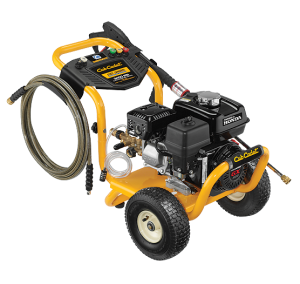 Like any piece of small equipment, getting the most out of a Cub Cadet pressure washer requires some occasional maintenance. However, the combination of water and high pressures makes maintenance on this type of equipment is a bit different from taking care of a lawn mower or a leaf blower. This guide will help you keep any of Cub Cadet’s current pressure washer models running including the CC3224, CC3425 and CC4033.
Like any piece of small equipment, getting the most out of a Cub Cadet pressure washer requires some occasional maintenance. However, the combination of water and high pressures makes maintenance on this type of equipment is a bit different from taking care of a lawn mower or a leaf blower. This guide will help you keep any of Cub Cadet’s current pressure washer models running including the CC3224, CC3425 and CC4033.
Before You Begin: Steps for Staying Safe
Before performing any repairs or maintenance, disconnect the spark plug wire and let the engine cool completely to prevent burns and injuries from accidental engine start-up. The washer should also be depressurized to prevent cuts and injection wounds. To do this, shut off the engine, turn off the water supply and hold down the gun trigger.
Never work on the pressure washer around sparks or open flame as there’s a chance of igniting the fuel in the engine and gas tank.
Never use an air tank or compressor to fill the tires unless a pressure regulator is used. The high air pressure from these devices can rapidly inflate the tire, causing it to burst, resulting in injuries and property damage. Never inflate the tire past the pressure stated on the sidewall.
The warranty is void if the engine governor has been altered or if the washer has been abused or neglected. Doing either isn’t just harmful to the pressure washer: the resulting failures can be extremely dangerous for the operator.
All adjustments should be checked at least once each season no matter how much the washer has been used.
Periodically check and re-tighten all fasteners, inspect hoses for damage and check the tire pressure. Always replace damaged hoses immediately: high pressure leaks are just as dangerous as the water spraying out of the nozzle.
Pump Oil
The pump oil should be changed after the first 50 hours of operation, then every 100 hours or 3 months thereafter. Simpson Premium Pump Crankcase Oil is recommended, but it can be substituted with SAE 15W-40 oil.
To check the oil level, look at the sight glass on the side of the pump. The oil should come up to the dot at the center of the glass.
To replace the oil, do the following:
1. Remove the oil fill plug on the top of the pump.
2. Place a container below the pump oil drain plug, then remove the drain plug.
3. Once the pump is empty, replace the drain plug.
4. Fill the pump with oil and reinstall the fill plug.
Nozzle Cleaning
A clogged nozzle can increase internal pressures causing damage throughout the washer. Usually, the first sign of a clogged nozzle is pulsation felt through the handle while spraying. Operation should be stopped immediately and the nozzle cleaned before restarting:
1. Shut off the motor and turn off the water supply.
2. Pull the trigger on the gun to relieve any remaining water pressure.
3. Disconnect the spray wand from the gun.
4. Remove the nozzle from the wand. Use the included cleaning tool to remove any debris from the nozzle by pushing the end through the front opening and then twisting and moving the tool in and out of the nozzle. Hose down the front of the nozzle for 30 seconds to backflush any remaining debris.
6. Put the nozzle back on the wand, then reattach the wand to the gun.
Water Inlet Filter
This metal screen is located inside the water inlet, the place where the garden hose attaches to the pump. To clean it, pull it out of the opening and run a stream of water through it to flush out any debris. When reinstalling the filter, make sure the top of the dome-shaped screen is facing away from the pump. Never run the pump without this filter installed.
Engine Care
No matter which powerplant is installed in your washer, there are some general recommendations that will help you maintain performance:
Low power and flooding can usually be traced back to a dirty air filter.
The spark plug should be cleaned and re-gapped each season.
Wiping away dirt, grass and other debris will help keep the engine cool.
Fresh fuel is critical to the performance and reliability of your pressure washer’s engine. If the engine is stored for 30 to 90 days between uses, the fuel should be treated with a stabilizer like Sta-Bil. For longer term storage, the fuel tank and carburetor should be drained.
Refer to engine manual that came with your pressure washer for instructions for your model’s motor.
Where to buy Parts for Your Cub Cadet Pressure Washer
Whether you have the CC3224, CC3425 or CC4033, you can get anything you need to keep your pressure washer in working order from cubparts.com from filter screens to lubricants. Need help? Access complete parts diagrams direct from their website or talk to one of their experienced parts staff.
